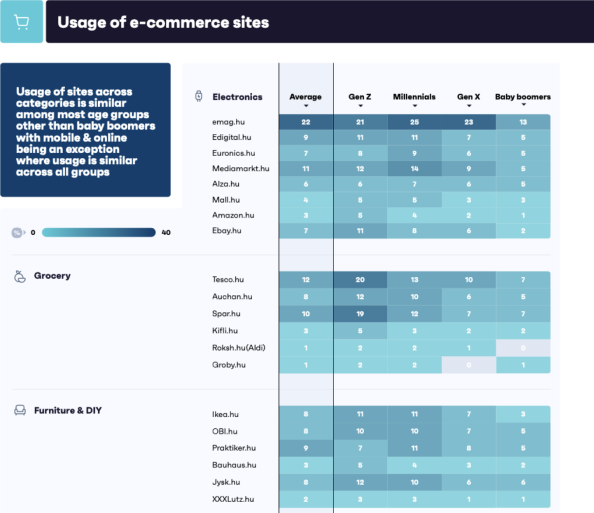Generation Z is the engine of e-commerce in Hungary
GWI has published results on the use of e-commerce platforms and related consumer habits in the Hungarian market. The survey revealed that the telecommunications and electronics sectors are the most dominant online presence among the total population, and are the winners of the digitalisation of commerce.
Generation Z is the engine of e-commerce in Hungary
GWI, in partnership with Publicis Groupe Hungary, has published for the first time in its history results on the use of e-commerce platforms and related consumer habits in the Hungarian market. The survey revealed that the Generation Z age group, aged 18-25, is the most intensive e-commerce user, while the telecommunications and electronics sectors are the most dominant online presence among the total population, and are the winners of the digitalisation of commerce.
For the first time in its history, Publicis Groupe Hungary has initiated a survey in Hungary and published the results of the survey, conducted by GWI, one of the world’s largest research companies mapping consumer habits.The survey, conducted in the third quarter of 2021, interviewed 2,000 Hungarian internet users aged 16-64 and analyses consumer habits in areas such as e-commerce, digital health services, social media, computer games and the impact of COVID-19.
You may download the study from here: Download
In the e-commerce area, GWI asked respondents one of the most market-driving questions: how often users use a given platform and compared user activity by age group on the platforms that users report using regularly. The platforms were electronics, shopping, furniture & DIY, telecoms, food, books, beauty, clothes & shoes and health. Based on the responses, it is clear that Generation Z, those born after 1997, are driving the development of the e-commerce sector: they are the most frequent online shoppers in most areas. For example, they regularly do their weekly shopping digitally (tesco.hu – 20%), order food (netpincer.hu – 27%), buy beauty products (rossmann.hu – 26%) or buy shoes (deichmann.hu – 14%).
Generation Z’s leadership is not yet evident in two major areas: one is electronics, where Generation Y members aged 26-39 are slightly more active (e.g. emag.hu: 25% vs. 21%), typically due to higher purchasing power and higher basket values. Telecoms is the other sector where Generation X (40-58 year olds) and baby boomers (59-64 year olds) are catching up with Generation Z (e.g. telekom.hu: 33% vs. 27% vs. 27%). “The biggest telco players – Telekom, Vodafone and Telenor – have an exceptionally high propensity to buy regardless of age, which means that this sector has managed to digitise its services the most,” said Szilvia Szarka, performance director at Publicis Groupe Hungary, specialising in e-commerce.

In the other categories, there are few stand-out players, i.e. those that have traditionally digitised offline purchases well, but emag.hu (22% of all users use it regularly) and netpincér.hu stand out with 16% of the total population surveyed.
Although healthcare products are not traditionally a popular destination for online shopping (7% and below in the overall sector), there do seem to be players that are finding and reaching a younger audience. One such site is benu.hu, which is regularly visited by 9% of Generation Z.
“The real value of GWI’s research is that the consumer habits of Hungarians can be studied in isolation, while the data can be interpreted in a global context. The trend analysis is an important step towards being able to benchmark Hungarian players against each other and against the most successful international companies.” summarised Rita Horváth, Chief Media Officer at Publicis Groupe Hungary.
About GWI
GWI was founded by Tom Smith in 2009 in the UK. The company provides publishers, media agencies and marketing professionals worldwide with insights into the buying habits of their target audiences. GWI profiles consumers in 47 countries with a panel of 18 million connected consumers, available through a subscription platform.
The national survey of internet users aged 16-64 was conducted in the form of an online questionnaire with 2002 respondents in Q3 2021. The data are representative of the Hungarian internet using population.